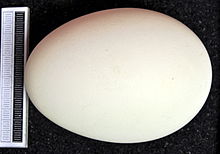Swan goose
| Swan goose | ||||||||||||
|---|---|---|---|---|---|---|---|---|---|---|---|---|

Swan Goose ( Anser cygnoid ) |
||||||||||||
| Systematics | ||||||||||||
|
||||||||||||
| Scientific name | ||||||||||||
| Anser cygnoid | ||||||||||||
| ( Linnaeus , 1758) |
The swan goose ( Anser cygnoid , spelling variant : Anser cygnoides ) is a species of the genus field geese ( Anser ) in the family of the duck birds (Anatidae). Swan geese were probably kept in China as early as 3000 years ago. The domesticated form of the swan goose that developed from this attitude is the hump goose .
The field goose species swan goose should not be confused with a domestic goose breed also known under this name , which is also known as the Emder goose .
features
The swan goose is a predominantly brown, very large goose species. The long neck, which is light cream-colored on the front and sharply separated from it on the back, is brown. The top of the head is also brown to reddish brown. The swan goose has a long, dark beak, the base of which is lined with white. The straight ridge line of the beak is characteristic of the wild form. The male has a hint of a slight swelling on the beak.
The males are significantly larger and heavier than the females. They weigh around 3.5 kilograms, while the females weigh between 2.8 and 3.3 kilograms.
The call of the swan goose is wide-sounding, stretched and hoarse-looking trumpeting. It is particularly common to hear of flying swan geese. Swan geese, alarmed by something, emit a harsh short call that is repeated.
Habitat and Distribution
The bird breeds in Siberia and Mongolia and winters in China between the Yangtze and Canton .
Swan geese came to Europe quite late, in the 1920s, and were brought to Europe for the first time in 1937. Pure swan geese can be found in Germany, for example, in the Berlin zoo .
In Europe there is a wild population in the Rhine-Neckar region . In Heidelberg the animals are mainly found on the Neckarwiese . In 2004 the population comprised around 180 animals, but was then reduced to around two dozen animals by the city administration. There are also around 40 geese in the not far away Rheinauen around Lampertheim . These small extent with their domesticated form, Höckergans , verbastardierten go well birds to animals back, which were brought to breed in Holland for the first time 1,956th Two wild-caught swan-goose and two humpback geese were used for breeding, which were then backcrossed with swan-goose. These free-living populations are problematic because they often hybridize with gray geese in Central Europe. This creates intermediate mixed types.
Way of life
Swan geese return to the breeding areas quite late, in April, where they often breed in colonies on small islands in lakes, in reeds or on the dry forest floor. The 5 to 8 pale cream-colored eggs are laid in May and incubated for 28 to 30 days. After about 10 weeks, the young fledglings and move with the adults to the wintering areas in September.
Like many geese, the swan goose feeds primarily on grass and herbs as well as seeds. In addition, it also eats roots and rhizomes of marsh plants in its natural range .
Inventory development
In the 1970s there was a game population of around 10,000 animals in Asia , but this is declining due to hunting . The IUCN has currently classified the swan goose from “critically endangered” to “endangered”. The reason for the changed assessment is better knowledge about the population level. The distribution areas in Russia have shrunk to island-like breeding areas. There are more stable breeding occurrences in western Mongolia as well as in northern and eastern central China.
Individual evidence and further information
Individual evidence
- ↑ Kolbe, p. 104
- ↑ Kolbe p. 102
- ↑ Hans-Heiner Bergmann; Hans-Wolfgang Helb; Sabine Baumann; The voices of the birds of Europe - 474 bird portraits with 914 calls and chants on 2,200 sonograms , Aula-Verlag, Wiesbaden 2008, ISBN 978-3-89104-710-1
- ↑ reassessment IUCN
- ↑ Kolbe, p. 103
literature
- Janet Kear (Ed.): Ducks, Geese and Swans. Oxford University Press, 2005, ISBN 0-19-854645-9 .
- Josep del Hoyo et al .: Handbook of the Birds of the World. Volume 1: Ostrich to Ducks. Lynx Edicions, 1992, ISBN 84-87334-10-5 .
- Hartmut Kolbe: The world's ducks. Ulmer Verlag, 1999, ISBN 3-8001-7442-1 .
Web links
- Anser cygnoid in the Red List of Threatened Species of the IUCN 2008. Posted by: BirdLife International, 2008. Accessed January 31 of 2009.
- Swan Goose feathers



